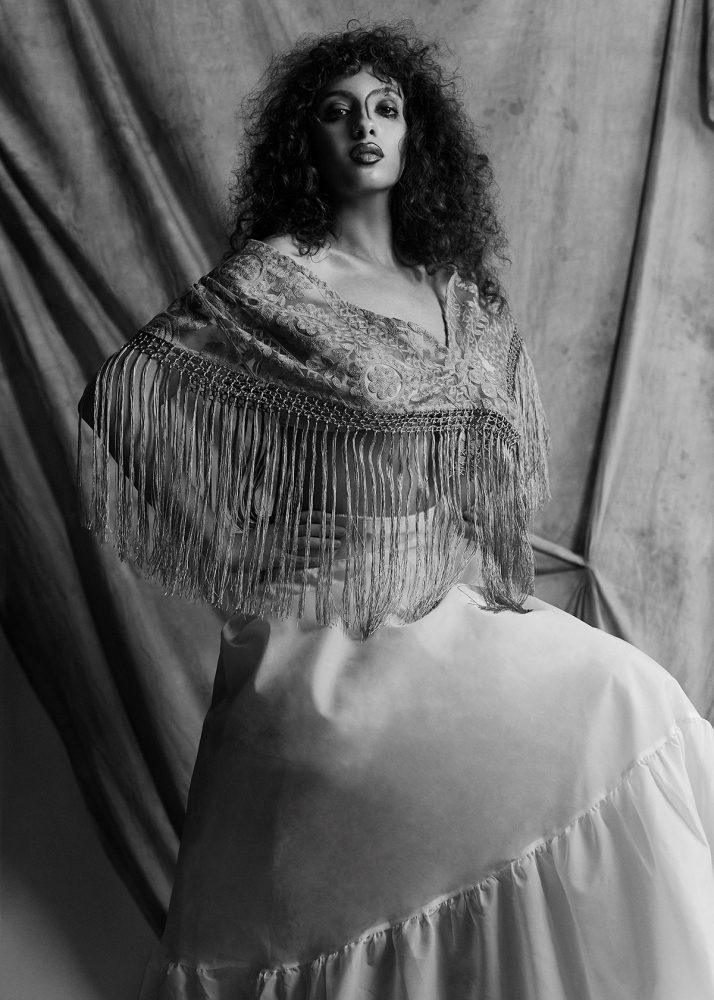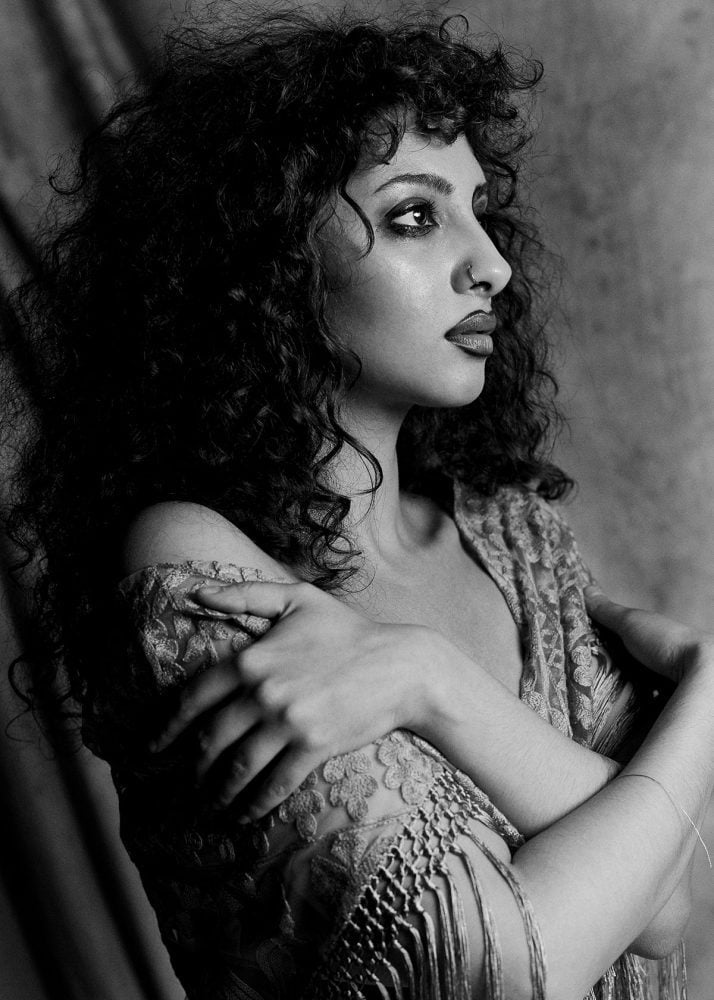Sadaf H Nava is an Iranian-born, New York-based artist and composer whose work spans film, sound, drawing, painting, and performance. Sadaf has presented work at MoMa PS1, Issue Project Room, Luma Westbau, and Performa, among others, and her work has been featured in Pitchfork, The Wire, i-D, V Magazine, The FADER and The Guardian. She released her first full-length LP, History of Heat, in 2019.
On Friday February 24, Sadaf will perform at the Institute for Contemporary Art at VCU, as part of the spring opening of the exhibition So it appears. Here she talks with ICA Curator of Performance David Riley about her influences and the process behind her elaborate multimedia performances.

Photo by John Spyrou
Hi Sadaf. Can you talk about your background growing up, and how crossing many different borders influenced your art career?
Yeah, for sure. I was born in Iran, in Isfahan, where I lived until I was about seven. Then we immigrated to Canada, to Toronto, and then Vancouver, which is where I went to high school. After that I moved to Montreal for university where I went to art school. I studied painting and photography, and that’s also the place where I started to make music. I had played violin my whole life, but I was never a very good classical musician. Eventually I decided to play the violin in my own way, in an improvisational way, which opened up a different kind of music making to me. Montreal was a place of collaboration. A lot of bands gathered there, and there was a really big noise and avant-garde music scene, and I found it more exciting than the gallery scene. The nightlife and the music I experienced living in Montreal was pretty formative. After that I moved to New York. That was around ten years ago, and I performed at a lot of DIY venues in Brooklyn. I think they’re all shut down now. And so here we are.
Your 2019 album History of Heat begins with a voice, in French, saying, “I love life, I want to live, I want a story.” The album feels like fragmented memories, with vocals, violins, samples, smashing glass, and glitches. What was the process of making that album?
It was a really long process, actually. The base of a lot of those songs were recorded years prior, but when the different parts came together, it naturally became very cohesive. It’s not necessarily fragments of memories, but I would call it autofiction––it’s not exactly autobiographical, but it’s a fantastical re-imagining.
When I listen to it, I know what it’s pointing to, but that is only clear to me. I feel that poetically speaking, a lot of things are easier said in French, or have a different tonality or aesthetic which worked well in this case. I love music that’s polyglot, that uses a lot of different languages. I think it’s beautiful to incorporate these different registers. And that’s why now I’m studying comparative literature, which is exactly that, the intersection of different languages.
You are pursuing your PhD at Rutgers University?
Yes, and at Rutgers, my focus is also French literature, Farsi and English and eventually maybe German, just because that’s a very useful language for reading philosophy or theory.
In some of your past performances, you have incorporated drawings, video, installations, as well as elaborate costumes and makeup. How do these many different practices come together in your idea of a live performance?
I have had gallery shows, and performed in gallery spaces, as well as music venues, and they’re usually treated very separately. But all these elements do work all together. There are links between the paintings, the video work, and the construction of a performing persona or a theatrical persona. It’s not that different for me to make music or to do visual or video work. I don’t really separate them because the influences are all very similar and the process is very similar, it always starts with improvisation.
For the performances that allow it, I like to have an installation aspect or a visual aspect because it adds another layer of perception and I think that makes the experience of the performance richer. And something remains, there’s a structural element or an architectural element, which I’m excited to do for the performance at the ICA as well.

Photo courtesy of Sadaf H Nava
You mentioned the idea of personas in your performances, and I feel like you subvert this traditional image of a muse, a character that is glamorous, even hyper feminine. You reference Brigitte Bardot on one hand, but then also French philosophy, and then also punk and noise music. How are you playing with the idea of “the muse”?
I often feel bombarded with culture. I’m drawn to an overwhelming array of voices and different influences which co-exist in my work. I tend to have many opposing drives at the same time and they really are genuine interests and drives. But I will say that, to self analyze, I think it’s interesting to have a very glamorous image transposed onto music that’s quite harsh, so that it draws people in and then shocks them a little bit, because it’s not what they were expecting. People usually expect something more entertaining because of the image. The muse relationship, I think that happens because I direct myself which gives me an element of control. I’m kind of a control freak. I want to be an actress, but I usually mistrust other people directing me. So then I end up having to do it myself. It also comes from an interest in auteur cinema, where it’s often written, directed, and produced by the same person, which results in a unified aesthetic.
Do you have a dream director you’d want to work with?
I don’t know, I’m stuck in the past a little bit. But currently it would probably be Bruno Dumont, I would say. I find him super interesting, he actually studied philosophy before filmmaking. His films are poetic but more harsh than glamorous, although his last film was satirically glamorous.
I want to pick up on something you just mentioned, where you said you’re stuck in the past a little bit. It feels like there is some nostalgia in your work about the avant-garde of the past, and the way that we romanticize artists. Do you think the avant-garde still exists, and in what form? How has it changed?
It has changed. Culture has changed, and I think technology is a huge part of that. New York has changed, funding has changed for artists, taste has changed for sure. I’m nostalgic for the past I didn’t know, but I do think the avant-garde still exists, it’s just that we’re too close to it to be able to see it. I think that in 20 or 30 years we’ll be better able to identify what the avant-garde of our time was. It’s easy to turn to the past because we have the archive to refer back to. But the future is so uncertain.

Photo by John Spyrou
I don’t think you’re alone in this, I feel that myself too. I have also heard some artists with connections to the Middle East speak nostalgically about the fifties and sixties, as a time when there was a brief flash of political freedom, a sort of lost moment.
Yeah, absolutely. I also have a kind of nostalgia for the sort of music that my parents listened to, or that aesthetic, that feeling. I have a similar feeling about theory. There was a moment where intellectual life was very in fashion, when philosophers were regularly on television because there was more of a collective interest. I feel that a lot of what people were fighting for in the 60’s and 70’s is coming back and is still relevant today, the themes happening around the sexual revolution and women’s movements for example. And the avant-garde as well, New York in the seventies, eighties and nineties, seems very exciting to me for music and art making and it’s still happening for sure but not in the same way. I hope that we’re part of that history. Maybe in 30 years someone’s going to look back at our time and think, what an ideal moment. And they’re going to say, I wish it was like that now. Or maybe not, maybe it’s going to get better.
Let’s meet up in 30 years! On February 24, you will be performing at the ICA’s spring opening of “So it appears”, a group show that illustrates how different artists use abstraction to communicate hidden meanings, or to represent things that are difficult or even impossible to represent otherwise. For me, there’s a tension in the exhibition between what is visible and what is invisible. Can you tell us what to expect from your performance, and how it relates to these ideas?
Yeah, that’s a great tie in because the performance itself also plays with the visible and invisible through a structural imposition that abstracts the physical body of the performer, which appears and disappears into it, coming in and out of focus. At the same time, it’s also about materializing the sound itself, through moments of clarity within abstraction. After a period of time, the ear adjusts to these patterns, and it starts to understand this new language. I think finding the figurative in the abstract, in a performative sense, is what to expect––without saying too much about it.
Yes, let’s leave some mystery to it.
Sadaf H Nava will be presenting a live performance at the Institute for Contemporary Art at VCU on Friday February 24 at 8:30pm, in between sets by DJ Haram. Following the ICA’s spring opening, both Sadaf and DJ Haram will also be DJing at Fallout, starting at midnight.
Main photo courtesy of Sadaf H Nava



